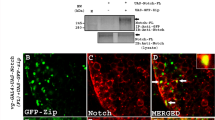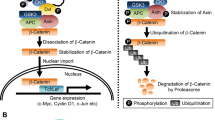Abstract
The Wnt proteins constitute a large family of extracellular signalling molecules that are found throughout the animal kingdom and are important for a wide variety of normal and pathological developmental processes1,2. Here we describe Wnt-inhibitory factor-1 (WIF-1), a secreted protein that binds to Wnt proteins and inhibits their activities. WIF-1 is present in fish, amphibia and mammals, and is expressed during Xenopus and zebrafish development in a complex pattern that includes paraxial presomitic mesoderm, notochord, branchial arches and neural crest derivatives. We use Xenopus embryos to show that WIF-1 overexpression affects somitogenesis (the generation of trunk mesoderm segments), in agreement with its normal expression in paraxial mesoderm. In vitro, WIF-1 binds to Drosophila Wingless and Xenopus Wnt8 produced by Drosophila S2 cells. Together with earlier results obtained with the secreted Frizzled-related proteins1,2, our results indicate that Wnt proteins interact with structurally diverse extracellular inhibitors, presumably to fine-tune the spatial and temporal patterns of Wnt activity.




Similar content being viewed by others
References
Wodarz, A. & Nusse, R. Mechanisms of Wnt signaling in development. Annu. Rev. Cell Dev. Biol. 14, 59–88 (1998).
Moon, R. T., Brown, J. D. & Torres, M. WNTs modulate cell fate and behavior during vertebrate development. Trends Genet. 13, 157–162 (1997).
Glinka, A. et al. Dickkopf-1 is a member of a new family of secreted proteins and functions in head induction. Nature 391, 357–362 (1998).
Hoppler, S., Brown, J. D. & Moon, R. T. Expression of a dominant-negative Wnt blocks induction of MyoD in Xenopus embryos. Genes Dev. 10, 2805–2817 (1996).
Christian, J. L. & Moon, R. T. Interactions between XWnt-8 and Spemann organizer signaling pathways generate dorsoventral pattern in the embryonic mesoderm of Xenopus. Genes Dev. 7, 13–28 (1993).
Moon, R. T. et al. Dissecting Wnt signaling pathways and Wnt-sensitive developmental processes through transient misexpression analyses in embryos of Xenopus laevis. Development (suppl.), 85–94 (1993).
van Leeuwen, F., Harryman Samos, C. & Nusse, R. Biological activity of soluble Wingless protein in cultured Drosophila imaginal disc cells. Nature 368, 342–344 (1994).
Piccolo, S., Sasai, Y., Lu, B. & DeRobertis, E. M. Dorsoventral patterning in Xenopus : inhibition of ventral signals by direct binding of chordin to BMP-4. Cell 86, 589–598 (1996).
Zimmerman, L. B., De Jesus-Escobar, J. M. & Harland, R. M. The Spemann organizer signal noggin binds and inactivates bone morphogenetic protein 4. Cell 86, 599–606 (1996).
Hsu, D. R., Economides, A. N., Wang, X., Eimon, P. M. & Harland, R. M. The Xenopus dorsalizing factor gremlin identifies a novel family of secreted proteins that antagonize BMP activities. Mol. Cell 1, 673–683 (1998).
Cadigan, K. M., Fish, M. P., Rulifson, E. J. & Nusse, R. Wingless repression of Drosophila frizzled2 expression shapes the Wingless morphogen gradient. Cell 93, 767–777 (1998).
Finch, P. W. et al. Purification and molecular cloning of a secreted frizzled-related antagonist of Wnt signaling. Proc. Natl Acad. Sci. USA 94, 6770–6775 (1997).
Aruffo, A., Stamenkovic, I., Melnick, M., Underhill, C. B. & Seed, B. CD44 is the principal cell surface receptor for hyaluronate. Cell 61, 1303–1313 (1990).
Rebagliati, M. R., Toyoma, R., Haffter, P. & Dawid, I. B. Cyclops encodes a nodal-related factor involved in midline signaling. Proc. Natl Acad. Sci. USA 95, 9932–9937 (1998).
He, X., Saint-Jeannet, J.-P., Woodgett, J. R., Varmus, H. E. & Dawid, I. B. Glycogen synthase kinase-3 and dorsoventral patterning in Xenopus embryos. Nature 374, 617–622 (1995).
Peifer, M., Orsulic, S., Sweeton, D. & Wieschaus, E. Arole for the Drosophila segment polarity gene armadillo in cell adhesion and cytoskeletal integrity during oogenesis. Development 118, 1191–1207 (1993).
Evan, G. I., Lewis, G. K., Ramsay, G. & Bishop, M. J. Isolation of monoclonal antibodies specific for human c-myc proto-oncogene product. Mol. Cell. Biol. 5, 3610–3616 (1985).
Acknowledgements
We thank R. Moon for Xwnt8-Myc cDNA, J. Flanagan for the alkaline phosphatase plasmid, J. Corden for the mouse RNA polymerase II clone, B. Appel, L. Roman and D. Grunwald for cDNA libraries, and P. Bhanot and I. Munoz-Sanjuan for comments on the manuscript. Supported by the Howard Hughes Medical Institute (J.-C.H., A.R., P.M.S., C.H.S., R.N., J.N.).
Author information
Authors and Affiliations
Corresponding author
Rights and permissions
About this article
Cite this article
Hsieh, JC., Kodjabachian, L., Rebbert, M. et al. A new secreted protein that binds to Wnt proteins and inhibits their activites. Nature 398, 431–436 (1999). https://doi.org/10.1038/18899
Received:
Accepted:
Issue Date:
DOI: https://doi.org/10.1038/18899
- Springer Nature Limited
This article is cited by
-
Evaluating the effects of curcumin nano-chitosan on miR-221 and miR-222 expression and Wnt/β-catenin pathways in MCF-7, MDA-MB-231 and SKBR3 cell lines
Diagnostic Pathology (2024)
-
WNT-inhibitory factor 1-mediated glycolysis protects photoreceptor cells in diabetic retinopathy
Journal of Translational Medicine (2024)
-
Wnt/β-catenin signaling pathway in liver biology and tumorigenesis
In Vitro Cellular & Developmental Biology - Animal (2024)
-
Therapeutic progress and challenges for triple negative breast cancer: targeted therapy and immunotherapy
Molecular Biomedicine (2022)
-
Pathological oligodendrocyte precursor cells revealed in human schizophrenic brains and trigger schizophrenia-like behaviors and synaptic defects in genetic animal model
Molecular Psychiatry (2022)





